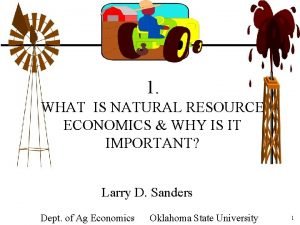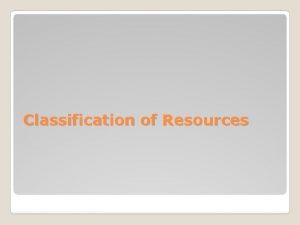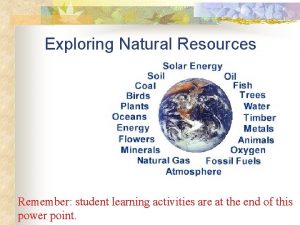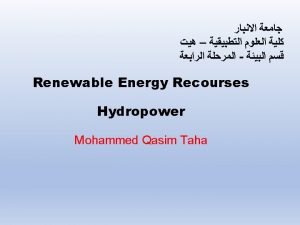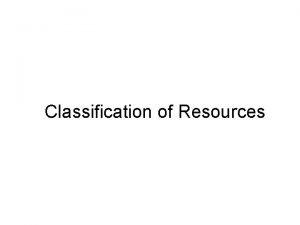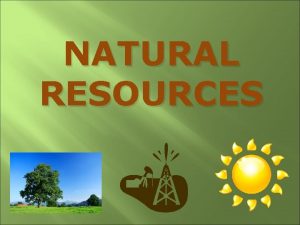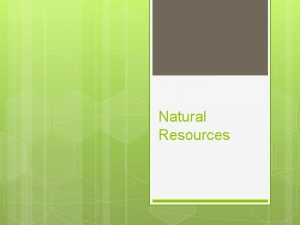Classification of Resources Natural resources occur naturally within








- Slides: 8

Classification of Resources

Natural resources occur naturally within environments that exist relatively undisturbed by mankind, in a natural form. A natural resource is often characterized by amounts of biodiversityand geodiversity existent in various ecosystems. Natural resources are derived from the environment. Many of them are essential for our survival while others are used for satisfying our wants. Natural resources may be further classified in different ways.


Classification • On the basis of origin, resources may be divided into: – Biotic resources are obtained from the biosphere, such as forests and their products, animals, birds and their products, fish and other marine organisms. Mineral fuels such as coal and petroleum are also included in this category because they are formed from decayed organic matter. – Abiotic resources include non-living things. Examples include land, water, air andminerals including ores such as gold, iron, copper, silver etc.

Considering their stage of development, natural resources may be referred to in the following ways: • Potential Resources – Potential resources are those that exist in a region and may be used in the future. For example, petroleum may exist in many parts of India, having sedimentary rocks but until the time it is actually drilled out and put into use, it remains a potential resource. • Actual Resources – Actual resources are those that have been surveyed, their quantity and quality determined and are being used in present times. The development of an actual resource, such as wood processing depends upon the technology available and the cost involved. • Reserve Resources – The part of an actual resource which can be developed profitably in the future is called a reserve resource • Stock Resources – Stock resources are those that have been surveyed but cannot be used by organisms due to lack of technology. For example. hydrogen

With respect to renewability, natural resources can be categorized as follows: • Renewable resources are ones that can be replenished or reproduced easily. Some of them, like sunlight, air, wind, etc. , are continuously available and their quantity is not affected by human consumption. Many renewable resources can be depleted by human use, but may also be replenished, thus maintaining a flow. Some of these, like agricultural crops, take a short time for renewal; others, like water, take a comparatively longer time, while still others, like forests, take even longer. • Non-renewable resources are formed over very long geological periods. Minerals and fossil fuels are included in this category. Since their rate of formation is extremely slow, they cannot be replenished once they get depleted. Of these, the metallic minerals can be reused by recycling them. [1] But coal and petroleum cannot be recycled. [2]

On the basis of availability, natural resources can be categorised as follows: • Inexhaustible natural resources- Those resources which are present in unlimited quantity in nature and are not likely to be exhausted easily by human activity are inexhaustible natural resources (sunlight, air etc. ) • Exhaustible natural resources- The amount of these resources are limited. They can be exhausted by human activity in the long run (coal, petroleum, natural gas, etc. )

On the basis of distribution, natural resources can be classified as follows: • Ubiquitous resources- Resources that are found everywhere are called ubiquitous resources. For example land, air • Localized resources- Resources that are found only at certain places are called localized resources. For example minerals, fossil fuels
 Classification of natural resources
Classification of natural resources Classification natural resources
Classification natural resources Types of resources
Types of resources Disadvantages and advantages of hydroelectric energy
Disadvantages and advantages of hydroelectric energy Naturally occurring areas of hydrothermal resources
Naturally occurring areas of hydrothermal resources Naturally occurring areas of hydrothermal resources
Naturally occurring areas of hydrothermal resources Natural hazards vs natural disasters
Natural hazards vs natural disasters Natural income
Natural income Australia major natural resources
Australia major natural resources
